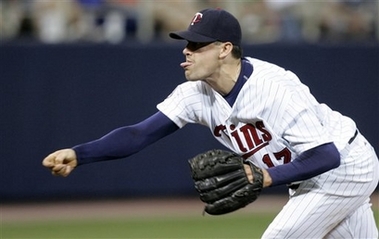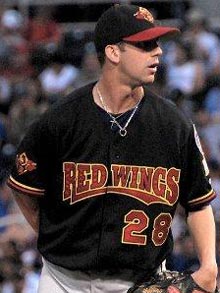July 27, 2008
One More Arm
Even with Nathan's brilliant work thrown into the mix, the bullpen has a 4.09 ERA in 213 post-Neshek innings. That's certainly not disastrous, but Twins relievers had a 3.42 ERA when Neshek was part of the bullpen and AL relievers as a whole have a 3.92 ERA this season. In other words, without Neshek around the bullpen has declined significantly while being worse than the AL average. That's obviously not a good sign and it's also not something the Twins have had to deal with recently.
A huge part of the Twins' success this decade has come from outstanding, deep bullpens featuring an excellent closer and multiple quality setup men. Because of that they haven't had a bullpen ERA above 3.99 since 2001, posting an average ERA of 3.59 during the past six seasons. Unfortunately, since losing Neshek nearly three months ago the bullpen has been mediocre at best and ranks as arguably the Twins' worst relief corps since Gardenhire took over as manager.
Ideally the Twins would acquire a top-notch setup man to replace Neshek, pushing the other relievers back into their previous, lower-leverage roles. That's a possibility with a few days remaining prior to the July 31 trading deadline, but Jon Rauch and Damaso Marte are already off the market and it's unlikely that the Twins will meet the asking prices for someone like Huston Street or Brian Fuentes. Instead, the Twins figure to stand pat, call up a reliever from Triple-A, or go after an inexpensive veteran.
 Standing pat would leave Nathan closing, Matt Guerrier and Jesse Crain as the primary setup men, and Dennys Reyes as the situational left-hander, with Craig Breslow, Brian Bass, and Boof Bonser in low-leverage roles. No bullpen with Nathan in the ninth inning can be that bad, Guerrier is a solid setup man, and Bonser still has a chance to be useful in relief, but that's not really a confidence-inspiring group and doesn't look particularly capable of being an elite bullpen down the stretch.
Standing pat would leave Nathan closing, Matt Guerrier and Jesse Crain as the primary setup men, and Dennys Reyes as the situational left-hander, with Craig Breslow, Brian Bass, and Boof Bonser in low-leverage roles. No bullpen with Nathan in the ninth inning can be that bad, Guerrier is a solid setup man, and Bonser still has a chance to be useful in relief, but that's not really a confidence-inspiring group and doesn't look particularly capable of being an elite bullpen down the stretch.
A call-up from Triple-A would seemingly point to Francisco Liriano, who racked up nine strikeouts last night and has been screaming for a promotion via his recent performance. He's 10-0 with a 2.93 ERA and 80-to-13 strikeout-to-walk ratio in 71 innings spread over his last 11 starts, but the Twins have indicated that they don't want to use him as a reliever. Instead, if Liriano rejoins the rotation that would likely lead to the Twins shifting Glen Perkins, Nick Blackburn, or Livan Hernandez to the bullpen.
Hernandez hasn't worked in relief since his MLB debut in 1996 and opponents have clobbered him to the tune of .336/.363/.500, so he wouldn't be any more bullpen help than Bass. Blackburn has more bullpen experience than Hernandez and would obviously be a better bet, but pitching to contact isn't a great fit in the late innings. Perkins' first 24 big-league appearances came out of the bullpen after he was strictly a starter in the minors, but Reyes and Breslow have been solid getting lefties out anyway.
Beyond calling up Liriano to start while moving Hernandez, Blackburn, or Perkins to relief, the staff at Rochester includes quite a few potential bullpen candidates in Bobby Korecky, Philip Humber, Danny Graves, Tim Lahey, Mariano Gomez, Ricky Barrett, Carmen Cali, Julio DePaula, and Casey Daigle. Neshek showed two years ago that a reliever can come up from Triple-A and immediately thrive in a high-leverage role, but unfortunately there's no Neshek at Rochester this season:
PA FIP SO% BB%
Bobby Korecky 226 2.85 22.6 6.2
Mariano Gomez 227 3.16 15.4 6.2
Ricky Barrett 226 3.16 28.3 12.4
Tim Lahey 217 3.66 20.7 6.5
Carmen Cali 247 3.82 18.2 6.9
Casey Daigle 265 4.30 20.8 9.4
Danny Graves 304 5.30 7.2 5.9
Julio DePaula 282 5.46 18.1 12.8
Philip Humber 396 5.64 15.2 9.8
If you're curious, Neshek had a 1.95 ERA and 87-to-14 strikeout-to-walk ratio in 60 innings at Triple-A when the Twins called him up in mid-2006. That adds up to a 2.48 FIP, which is 13 percent better than anyone on the above list has managed this season. Of course, there's no shame in a Triple-A reliever being worse than Neshek and Korecky's 2.85 FIP at Rochester is still plenty solid. Korecky has a 3.35 ERA and 51-to-17 strikeout-to-walk ratio in 53.2 innings as Rochester's closer.
 He also has a similarly strong minor-league track record in previous seasons and held his own in nine games with the Twins earlier this year, so if they want to add a bullpen arm from Triple-A it should be Korecky. With that said, he's more middle man than setup man, so there likely won't be any filling of Neshek's shoes. Gomez and Barrett would be options as situational left-handers if the Twins didn't already have Reyes and Breslow, and Lahey doesn't project as more than a decent middle reliever.
He also has a similarly strong minor-league track record in previous seasons and held his own in nine games with the Twins earlier this year, so if they want to add a bullpen arm from Triple-A it should be Korecky. With that said, he's more middle man than setup man, so there likely won't be any filling of Neshek's shoes. Gomez and Barrett would be options as situational left-handers if the Twins didn't already have Reyes and Breslow, and Lahey doesn't project as more than a decent middle reliever.
Cali and Daigle have ugly stats in brief MLB stints and are pretty standard organizational filler at this point, DePaula has fallen apart after previously looking like a decent relief prospect, and Humber has been a huge disappointment since coming over in the Johan Santana trade. Graves is a recognizable name because of his two All-Star appearances as the Reds' closer, but he's now 33 years old, hasn't had success in the majors since 2004, and has been anything but impressive at Rochester.
Rochester is home to no shortage of potential middle relievers and mop-up men--which is yet another reason why hanging onto Bass all season makes such little sense--but unless the Twins change their mind about Liriano's short-term role Korecky is probably the only option there for adding a potential impact bullpen arm for the stretch run (and it's debatable if he even qualifies). Similarly, while dealing for Street or Fuentes is likely too expensive, acquiring a useful veteran arm shouldn't be too difficult.
Whether via call-up or trade it'll be very tough to bring in someone dependable and durable enough to supplant Guerrier as the primary setup man, but adding someone serviceable enough to be a viable alternative to Crain as the secondary setup man is very much doable. Crain has a 4.21 career FIP and his 4.00 mark this season ranks 90th among MLB relievers with at least 30 innings. His xFIP, which takes FIP a step further by normalizing home-run rate, is even higher at 4.48.
While useful, relievers with a 4.00-4.50 FIP simply aren't all that difficult to find. For instance, LaTroy Hawkins was designated for assignment by the Yankees this weekend. During his final two seasons with the Twins and first season with the Cubs, Hawkins was one of the best relievers in baseball, with a 2.22 ERA and 207-to-44 strikeout-to-walk ratio over 239.2 innings. Since then he's been merely a decent middle reliever, with a 4.27 ERA and 122-to-72 strikeout-to-walk ratio over 213 innings.
YEARS PA ERA FIP SO% BB%
2002-04 953 2.22 3.05 21.7 3.8
2005-08 906 4.27 4.29 13.4 6.8
Hawkins is a 35-year-old shell of his former self--his strikeouts have fallen 38 percent and his walks have risen 79 percent--but over the past four seasons he's still been Crain's equal. Even now, while posting a 5.71 ERA that convinced the Yankees to cut him loose, Hawkins has 4.11 FIP (compared to 4.00 for Crain) and 4.49 xFIP (compared to 4.48 from Crain). Contending teams cutting relievers whose secondary numbers are nearly identical to your No. 2 setup man is a sign that an upgrade is doable:
PA FIP xFIP SO% BB% GB% FBMPH
Crain 178 4.00 4.48 17.9 7.9 39.8 93.9
Hawkins 173 4.11 4.49 13.3 8.1 48.1 92.5
They both issue a walk eight percent of the time while working with an average fastball of 92-94 miles per hour. Crain misses about 30 percent more bats, Hawkins induces about 25 percent more ground balls, and the end result (if you're smart enough to look beyond ERA) is almost identical. The point here isn't necessarily that the Twins should try to bring Hawkins back--although it's not a bad idea--but rather that finding another competent arm for the bullpen could be plenty helpful and is very feasible.
LATROY HAWKINS
YEAR PA FIP xFIP SO% BB% GB% FBMPH SLMPH
2005 247 4.39 4.48 17.4 8.5 44.3 93.6 86.6
2006 261 3.86 4.89 10.3 4.6 44.2 94.0 87.4
2007 225 4.47 3.98 12.9 6.7 63.3 93.5 87.1
2008 173 4.11 4.49 13.3 8.1 48.1 92.5 86.9
Hawkins can be had for next-to-nothing, relievers like him are readily available, Korecky is waiting at Triple-A for his next chance, and Perkins or Blackburn could be added to the bullpen if the Twins get around to calling up Liriano. Replacing Neshek will be impossible without busting the bank for a guy like Street and even adding a true late-inning arm probably isn't doable unless they decide to let Liriano relieve, but the bullpen could use another serviceable, non-Bass option and that's not too hard to find.
Once you're done here, check out my latest "Daily Dose" column over at Rotoworld.

